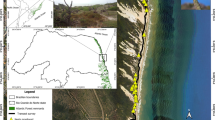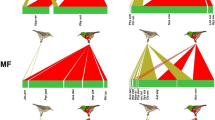Abstract
In an environment fluctuating in a predicatable manner with wide among-year variation in offspring mortality, fitness is largely influenced by the timing of reproductive investment. In vole-eating nocturnal Tengmalm's owls (Aegolius funereus), within-cycle variation in 1st-year survival of owlets is 3-fold as estimated by the recruitment probability of an offspring. It increases from the peak through the low to the increase phase of the vole cycle. We recorded prey delivery rates of males during a 3-year vole cycle using 4 h continuous recording at night. Males brought significantly more prey items per offspring in a low-vole year than in the increase and peak vole years. In the early night (10 p.m.–12 p.m.), males fed their families equally in the increase and peak vole years, whereas in the late night (0.01–2.00 a.m.) males reduced their feeding rate in the peak year but not in other years. Both prey number and prey mass per offspring were larger in the low and increase vole years than in the peak year, though in the peak phase food is most abundant. We suggest that feeding effort of site-tenacious, long-lived (mean lifespan 3.5 years) male owls culminates in the increase rather than in the peak phase of the vole cycle, because offspring survive better in the former phase.
Similar content being viewed by others
References
Andersson M (1978) Natural selection of offspring numbers: some possible intergeneration effects. Am Nat 112:762–766
Bell G, Koufopanou V (1986) The cost of reproduction. In: Dawkins R, Ridley M (eds) Oxford surveys in evolutionary biology. Oxford University Press, Oxford, pp 83–131
Carlisle TR (1982) Brood success in variable environments: implications for parental care allocation. Anim Behav 30:824–836
Clutton-Brock TH (1991) The evolution of parental care. Princeton University Press, Princeton
Degn HJ (1978) A new method of analysing pellets from owls etc. Dan Ornitol Fören Tidskr 72:143
Glutz von Blotzheim UN, Bauer KM (1980) Handbouch der Vögel Mitteleuropas. Akademische Verlagsgesellschaft, Wiesbaden
Goodman D (1979) Regulating reproductive effort in a changing environment. Am Nat 113:735–748
Hakkarainen H, Korpimäki E (1994) Nest defence of Tengmalm's owls reflects offspring survival prospects under fluctuating food conditions. Anim Behav (in press)
Halle S, Lehmann U (1992) Cycle-correlated changes in the activity behaviour of field voles, Microtus agrestis. Oikos 64:489–497
Hansson L (1984) Winter reproduction of small mammals in relation to food conditions and population dynamics. Bull Carnegie Mus Nat Hist 10:225–234
Hermann TB (1977) Activity patterns and movements of subarctic voles. Oikos 29:434–444
Hirschfield MF, Tinkle DW (1975) Natural selection and the evolution of reproductive effort. Proc Nat Acad Sci USA 72:2227–2231
Hörnfeldt B, Carlsson B-G, Löfgren O, Eklund U (1990) Effects of cyclic food supply on breeding performance in Tengmalm's owl (Aegolius funereus). Can J Zool 68:522–530
Korpimäki E (1981) On the ecology and biology of Tengmalm's Owl (Aegolius funereus) in Southern Ostrobothnia and Suomenselkä western Finland. Acta Univ Oulu Ser A Sci Rer Nat 118:1–84
Korpimäki E (1987a) Selection for nest-hole shift and tactics of breeding dispersal in Tengmalm's owl Aegolius funereus. J Anim Ecol 56:185–196
Korpimäki E (1987b) Timing of breeding of Tengmalm's owl Aegolius funereus in relation to vole dynamics in western Finland. Ibis 129:58–68
Korpimäki E (1987c) Prey caching of breeding Tengmalm's owls Aegolius funereus as a buffer against temporary food shortage. Ibis 129:499–510
Korpimäki E (1988a) Effects of territory quality on occupancy, breeding performance and breeding dispersal in Tengmalm's owl. J Anim Ecol 57:97–108
Korpimäki E (1988b) Diet of breeding Tengmalm's owls Aegolius funereus: long-term changes and year-to-year variation under cyclic food conditions. Ornis Fenn 65:21–30
Korpimäki E (1988c) Effects of age on breeding performance of Tengmalm's owl Aegolius funereus in western Finland. Ornis Scand 19:21–26
Korpimäki E (1992) Fluctuating food abundance determines the lifetime reproductive success of male Tengmalm's owls. J Anim Ecol 61:103–111
Korpimäki E, Hakkarainen H (1991) Fluctuating food supply affects the clutch size of Tengmalm's owl independent of laying date. Oecologia 85:543–552
Korpimäki E Lagerström M (1988) Survival and natal dispersal of fledglings of Tengmalm's owl in relation to fluctuating food conditions and hatching date. J Anim Ecol 57:433–441
Korpimäki E, Norrdahl K (1989) Avian and mammalian predators of shrews in Europe: regional differences, between-year and seasonal variation, and mortality due to predation. Ann Zool Fenn 26:389–400
Korpimäki E, Lagerström M, Saurola P (1987), Field evidence for nomadism in Tengmalm's owl Aegolius funereus. Ornis Scand 18:1–4
Lindström E (1988) Reproductive effort in the red fox, Vulpes vulpes, and future supply of a fluctuating prey. Oikos 52:115–119
Masman D, Dijkstra C, Daan S, Bult A (1989) Energetic limitation of avian parental effort: field experiments in the kestrel (Falco tinnunculus) J Evol Biol 2:435–455
Montgomerie RD, Weatherhead PJ (1988) Risks and rewards of nest defence by parent birds. Q Rev Biol 63:167–187
Murdoch WW (1966) Population stability and life history phenomena. Am Nat 100:45–51
Siivonen L (1974) Pohjolan nisäkkäät. Otava, Helsinki
Stearns SC (1976) Life history tactics, a review of the ideas. Q Rev Biol 51:3–47
Stearns SC (1989) Trade-offs in life-history evolution. Funct Ecol 3:259–268
Stearns SC (1992) The evolution of life histories. Oxford University Press, Oxford
Williams GC (1966) Natural selection, the costs of reproduction, and a refinement of Lack's principle. Am Nat 100:687–690
Ylönen H (1988) Diel activity and demography in an enclosed population of the vole Clethrionomys glareolus. Ann Zool Fenn 25:221–228
Author information
Authors and Affiliations
Rights and permissions
About this article
Cite this article
Hakkarainen, H., Korpimäki, E. Does feeding effort of Tengmalm's owls reflect offspring survival prospects in cyclic food conditions?. Oecologia 97, 209–214 (1994). https://doi.org/10.1007/BF00323151
Received:
Accepted:
Issue Date:
DOI: https://doi.org/10.1007/BF00323151




